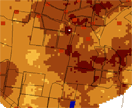The effect of a sodium salt is two fold. As an electrolyte sodium salts (e.g. NaCl, Na2SO4 or NaNO3) coagulate. However, as an exchangeable cation sodium tends to favour dispersion.
If soil is sodic (i.e. ESP > 6), clay dispersion declines as the salt concentration of the soil solution increases. Conversely, when soil is sodic and the salt concentration is negligible the soil will disperse easily. This is a common occurrence when rainwater falls upon sodic soil.
A recently developed expression which is increasingly being used to express the relationship between sodicity and salinity is the Electrochemcial Stability Index (i.e. ESI).
The ESI is determined by calculating the ratio of the electrical conductivity of a one part soil to five parts soil extract (EC1:5 – dS/m) and the exchangeable sodium percentage (ESP).
A tentative critical ESI value for Australian cotton soil is 0.05. An economically viable response to gypsum and/or lime can be expected where ESI values are at or below this level.
In order to manage soil structural decline as a consequence of excess sodium on the exchange complex, gypsum can be applied (calcium sulphate – CaSO4.2H2O). The best results will be achieved if the gypsum is dissolved.
The effect of the addition of gypsum in this way is two fold.
In the first instance, and because gypsum is a mildly soluble salt, the soil solution salinity increases. The effect is short lived as the gypsum is ultimately leached, but in the interim the increase in soil solution salinity mitigates the impact of the high soil ESP.
In the longer term the excess calcium entering the soil solution exchanges with the sodium and magnesium on the clay. Both of these may be leached during subsequent irrigation or rainfall events. As a result sodium and magnesium are removed with the calcium left behind to initiate the process of aggregation.


